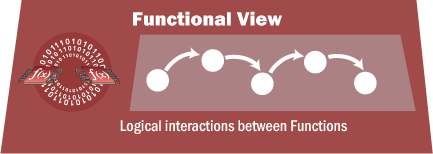Functional

The Functional View addresses the analysis of abstract functional elements and their logical interactions. Here CVRIA is depicted as a set of Processes organized hierarchically as collections of processes. These Processes (activities and functions) trace to a set of Requirements derived from the connected vehicle source documents. The data flows that move between processes and the data stores where data may reside for longer periods are all defined in a Data Dictionary.
The behavior of a Function (aka Process) is the set of actions performed by this element to achieve an objective. A Process performs actions to achieve an application objective or to support actions of another Process. This may involve data collection, data transformation, data generation, data generation or processing in performing those actions. The Functional View defines Processes to control and manage system behavior, such as monitoring, and other active control elements that are part of describing the functional behavior of the system. It also describes data processing functions, data stores and the logical flows of information among these elements.
The Functional View is modeled using a Structure Analysis methodology. This uses the existing National ITS Architecture's Logical Architecture as the starting point that was based on the work of Hatley/Pirbhai and included Yourdon-Demarco Data Flow Diagrams (DFDs) to illustrate the flow of data between functional elements. For expedience in CVRIA the diagrams are not included – just the collections of processes and their data flows. The reader should use the Physical view diagrams for graphical representations of the system behavior.